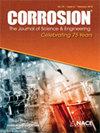近表面严重塑性变形对GTD-111镍高温合金在氢氟酸溶液中腐蚀行为的影响
IF 1.1
4区 材料科学
Q4 MATERIALS SCIENCE, MULTIDISCIPLINARY
引用次数: 0
摘要
采用高能喷丸强化(HESP)作为一种常见的近表面严重塑性变形(NS-SPD)方法,在GTD-111 Ni高温合金表面形成了具有超细晶粒和致密晶界、位错、孪晶等晶体缺陷的严重变形表面。采用浸渍试验、掠射x射线衍射(GI-XRD)分析、电化学技术和辉光发射光谱(GDOES)等方法,比较研究了HESPed GTD-111和溶液退火GTD-111的氟致腐蚀性能。浸没测试和电化学测量结果表明,HESPed GTD-111的腐蚀膜具有更高的电阻和更低的无源电流密度,但初始腐蚀速率较高。两个样品都遭受点蚀;然而,溶液退火后的合金则显示出更深更大的凹坑。在HESPed试样表面密集分布的晶体缺陷显著增加了合金元素向腐蚀前沿的扩散。GDOES深度剖面显示:(1)在HESPed样品上形成较厚的腐蚀膜,合金元素(即Cr、Ti、Co和Al)的贡献较高;(2)在溶液退火和HESPed样品上形成的腐蚀膜由外层富f区和内部富o区组成。通过物理模型探讨了NS-SPD的保护机制。本文章由计算机程序翻译,如有差异,请以英文原文为准。
Influence of near-surface severe plastic deformation (NS-SPD) on the corrosion behavior of GTD-111 nickel superalloy in hydrofluoric acid solution
High energy shot peening (HESP) as a common near-surface severe plastic deformation (NS-SPD) was employed to create a severely deformed surface with ultrafine grains and dense crystallographic defects (e.g., grain boundaries, dislocations, and twins) on GTD-111 Ni superalloy. The fluoride-induced corrosion performance of HESPed GTD-111 and its solution-annealed counterpart is comparatively studied using immersion tests, grazing-incidence X-ray diffraction (GI-XRD) analysis, electrochemical techniques and glow discharge optical emission spectroscopy (GDOES). As supported by the immersion tests and electrochemical measurements, HESPed GTD-111 exhibits corrosion film with higher resistance and lower passivity current density at the expense of a higher initial corrosion rate. Both samples suffer pitting corrosion; however, the solution-annealed one shows deeper and larger pits. The dense distribution of crystallographic defects on the surface of HESPed sample significantly increases the diffusion of alloying elements to the corrosion front. The GDOES depth profiles reveal that (i) a thicker corrosion film with a higher contribution of alloying elements (namely, Cr, Ti, Co, and Al) is developed on the HESPed sample, and (ii) the corrosion films formed on the solution-annealed and HESPed samples consist of an outer F-rich part and an inner O-rich region. The protective mechanism of NS-SPD is discussed by a physical model.
求助全文
通过发布文献求助,成功后即可免费获取论文全文。
去求助
来源期刊

Corrosion
MATERIALS SCIENCE, MULTIDISCIPLINARY-METALLURGY & METALLURGICAL ENGINEERING
CiteScore
2.80
自引率
12.50%
发文量
97
审稿时长
3 months
期刊介绍:
CORROSION is the premier research journal featuring peer-reviewed technical articles from the world’s top researchers and provides a permanent record of progress in the science and technology of corrosion prevention and control. The scope of the journal includes the latest developments in areas of corrosion metallurgy, mechanisms, predictors, cracking (sulfide stress, stress corrosion, hydrogen-induced), passivation, and CO2 corrosion.
70+ years and over 7,100 peer-reviewed articles with advances in corrosion science and engineering have been published in CORROSION. The journal publishes seven article types – original articles, invited critical reviews, technical notes, corrosion communications fast-tracked for rapid publication, special research topic issues, research letters of yearly annual conference student poster sessions, and scientific investigations of field corrosion processes. CORROSION, the Journal of Science and Engineering, serves as an important communication platform for academics, researchers, technical libraries, and universities.
Articles considered for CORROSION should have significant permanent value and should accomplish at least one of the following objectives:
• Contribute awareness of corrosion phenomena,
• Advance understanding of fundamental process, and/or
• Further the knowledge of techniques and practices used to reduce corrosion.
 求助内容:
求助内容: 应助结果提醒方式:
应助结果提醒方式:


